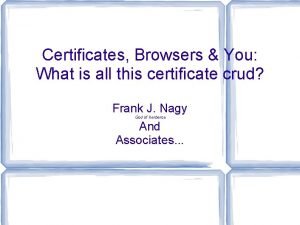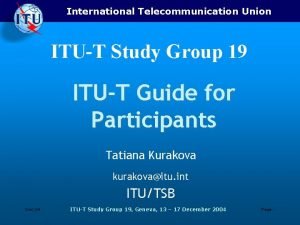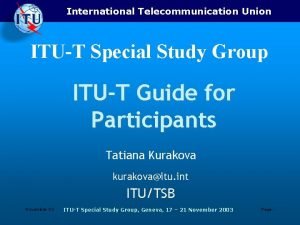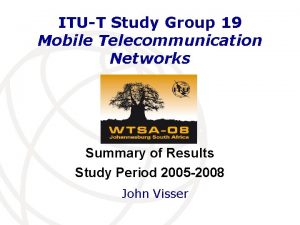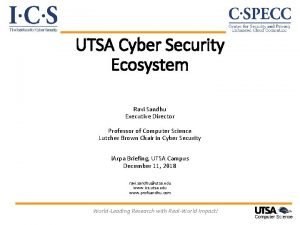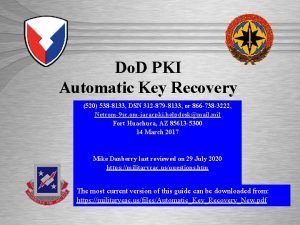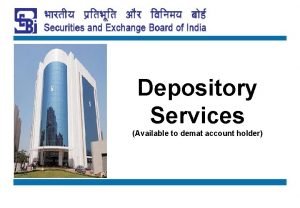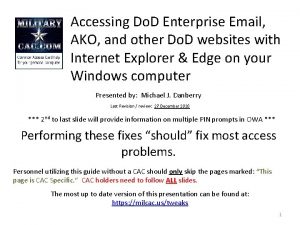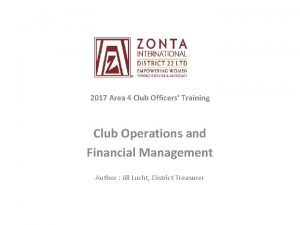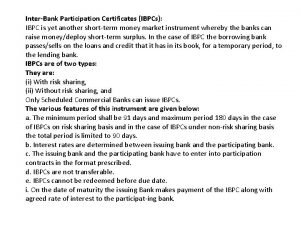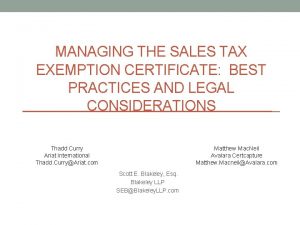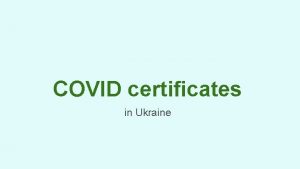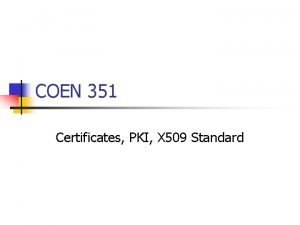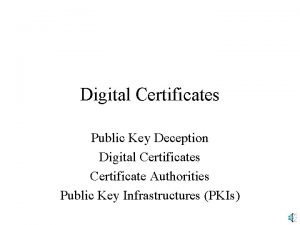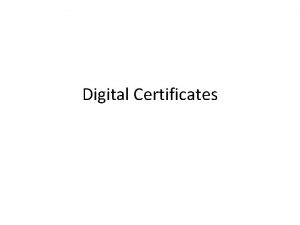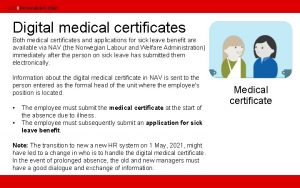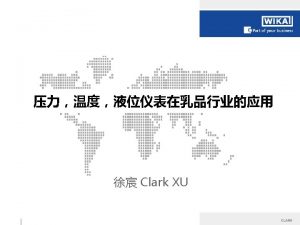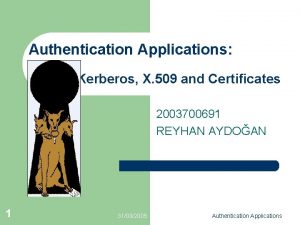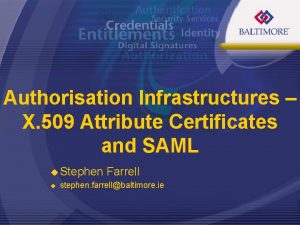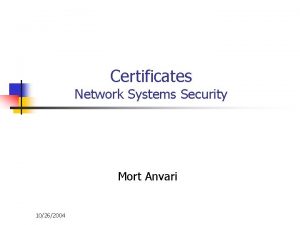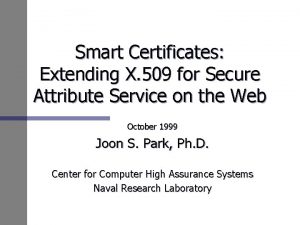Digital Certificates and X 509 X 509 ITUT














- Slides: 14

Digital Certificates and X. 509

X. 509 Ø ITU-T recommendation X. 509 is part of the X. 500 series of Ø Ø recommendations that define a directory service. The directory is, in effect, a server or distributed set of servers that maintains a database of information of users. X. 509 defines a framework for the provision of authentication services by the X. 500 directory to its users. Each certificate contains the public key of a user and is signed with the private key of a trusted certification authority. X. 509 is an important standard because the certificate structure and authentication protocols defined in X. 509 are used in a variety contexts. X. 509 was initially issued in 1988. The standard was subsequently revised to address some of the security concerns documented in [IAN 90] and [MITC 90]; a revisited recommendation was issued in 1993. A third version was drafted in 1995. X. 509 is based on the use of public-key cryptography and digital signatures.

Certificates Ø The heart of the X. 509 scheme is the public-key certificate associated with each user. Ø These user certificates are assumed to be created by some trusted certification authority(CA) and place in the directory by the CA or by the user. Ø The directory server itself is not responsible for the creation of public keys or for the certification function; it merely provides an easily accessible location for users to obtain certificates.

Certificates The general format of a certificate: Ø Version: Differentiates among successive versions of the certificate format; the default is version 1. If the Initiator Unique Identifier are present, the value must be version 2. If one or more extensions are present, the version must be version 3. Ø Serial number: An integer value, unique within the issuing CA, that is unambiguously associated with this certificate. Ø Signature algorithm identifier: The algorithm used to sign the certificate, together with any associated parameters. Ø Issuer name: X. 500 name of the CA that created and signed this certificate. Ø Period of validity: Consists of two dates: the first and last on which the certificate is valid.

Certificates Ø Subject name: The name of the user to whom this Ø Ø certificate refers. Subject’s public-key information: The public key of the subject, plus an identifier of the algorithm for which this key is to be used, together with any associated parameters. Issuer unique identifier: An optional bit string field used to identify uniquely the issuing CA in the event the X. 500 name has been reused for different entities. Extensions: A set of one or more extension fields. Extensions were added in version 3. Signature: Covers all of the other fields of the certificate; it contains the hash code of the other fields, encrypted with the CA’s private key.

Certificates

Certificates Ø Y<<X>> means that the certificate of user X issued by certification authority Y. The CA signs the certificate with its secret key. If the corresponding public key is known to user, then that user can verify that a certificate signed by CA is valid.

Obtaining a User’s Certificate Ø User certificates generated by a CA have following characteristics: 1. Any user with access to the public key of the CA can recover the user public key that was certified. 2. No party other than the certification authority can modify the certificate without this being detected. Ø If all users subscribe to the same CA, then there is a common trust of the CA. All user certificates can be placed in the directory for access by all users. In addition, a user can transmit his or her certificate directly to other users.

Obtaining a User’s Certificate Ø If there is a large community of users, it may not be practical for all users to subscribe to the same CA. Because it is the CA that signs certificates, each participating user must have a copy of the CA’s own public key to verify signatures. This public key must be provided to each user in an absolutely secure way so that the user has confidence in the associated certificates.

Obtaining a User’s Certificate

Obtaining a User’s Certificate The picture in the previous slide shows the hierarchy of X. 509. The connected circles indicate the hierarchical relationship among the CAs ; the associated boxes indicate certificates maintained in the directory for each CA entry. The directory entry for each CA includes two types of certificates; 1. Forward certificates: Certificates of X generated by other CAs. 2. Reverse certificates: Certificates generated by X that are the certificates of other CAs.

Obtaining a User’s Certificate Ø In this example, user A can acquire the following certificates from the directory to establish a certification path to B: X<<W>>W<<V>>V<<Y>>Y<<Z>>Z<<B>> Ø When A has obtained these certificates, it can unwrap the certification path in sequence to recover a trusted copy of B’s public key. Using this public key, A can send encrypted messages to B. If A wishes to receive encrypted messages back from B, or to sign messages sent to B, then B will require A’s public key, which can be obtained from the following certification path: Z<<Y>>Y<<V>>V<<W>>W<<X>>X<<A>>

Revocation of Certificates Ø Typically, a new certificate is issued just before the expiration of the old one. In additional, it may be desirable on occasion to revoke a certificate before it expires, for one of the following reasons: 1. The user’s secret key is assumed to be compromised. 2. The user is no longer certified by this CA. 3. The CA’s certificate is assumed to be compromised. Ø Each CA must maintain a list consisting of all revoked but not expired certificates issued by the CA, including both those issued to users and to other CAs. Ø Each certificate revocation list(CRL) posted to the directory is signed by the issuer and includes the issuer’s name, the date the list was created, the date the next CRL is scheduled to be issued, and an entry for each revoked certificate.

Revocation of Certificates Ø Each entry consists of the serial number of a certificate and revocation date for that certificate. Because serial numbers are unique within a CA, the serial number is sufficient to identify the certificate. Ø When a user receives a certificate in a message, the user must determine whether the certificate has been revoked. The user could check the directory each time a certificate is received.
 Digital certificates in web browsers
Digital certificates in web browsers Itu t study groups
Itu t study groups Ittut
Ittut Itut
Itut Cabs itut
Cabs itut Cabs itut
Cabs itut Utsa cyber security certificate
Utsa cyber security certificate Recover old cac certificates
Recover old cac certificates Old defunct certificates surrendered for demat
Old defunct certificates surrendered for demat Adventurer club flag
Adventurer club flag Ako army enterprise email
Ako army enterprise email Certificates of currency for insurance
Certificates of currency for insurance Ibpc certificate
Ibpc certificate Certificates of obligation
Certificates of obligation Managing sales tax exemption certificates
Managing sales tax exemption certificates
